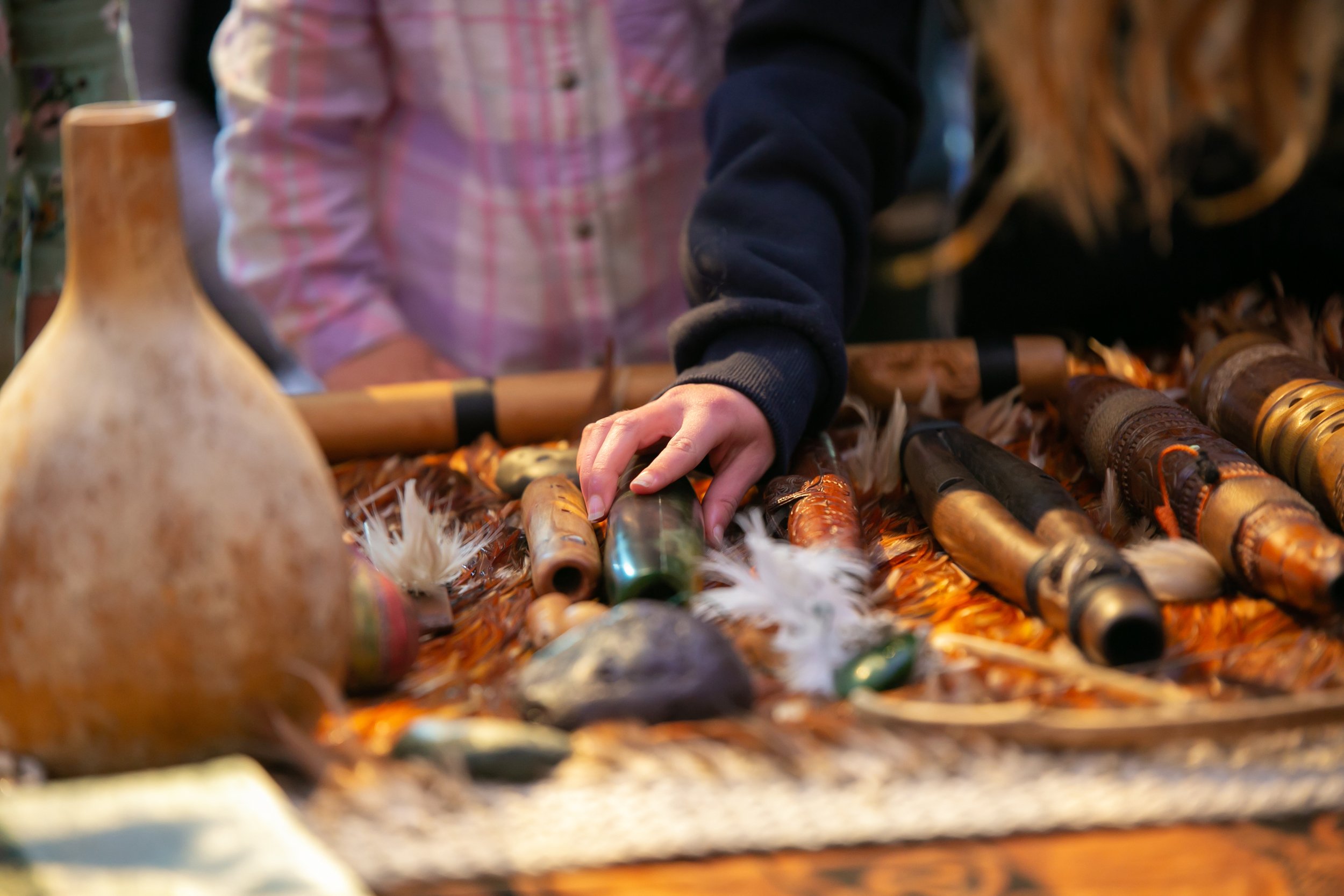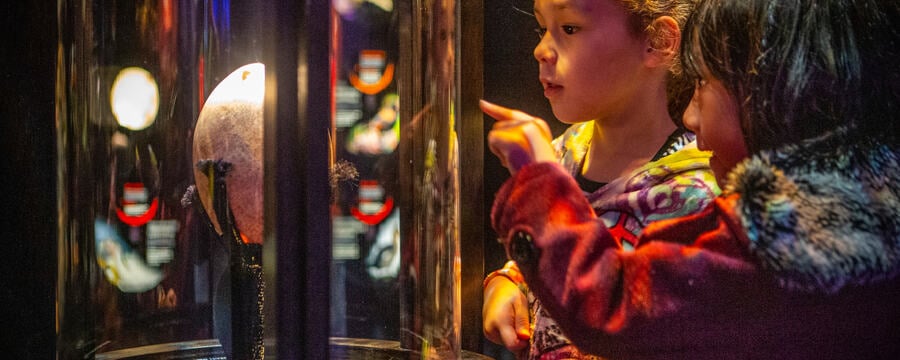Taonga Māori and Object-based learning

In this step we think about Object-based learning in connection with taonga Māori | Māori artefacts.
What are taonga Māori?
According to Te Aka – the Māori dictionary, a taonga is a ‘treasure, anything prized – applied to anything considered to be of value including socially or culturally valuable objects, resources, phenomenon, ideas and techniques’. This is a very broad definition. So for example te reo Māori language is considered a taonga, waiata | Māori songs are taonga, rongoā | Māori traditional medicine is a taonga etc.
In terms of the scope of this course, when thinking about Object-based learning, and the intersection with taonga Māori we are actually only focusing on one relatively small aspect of the broad concept of taonga, i.e. taonga in relation to physical objects or Māori artefacts, and in particular those items within museums. So the use of the term taonga Māori in this course needs to be understood in this context. It refers to physical objects and should be read as meaning Māori artefacts, and in particular, those that are within museum collections. However as you will see below, a Māori artefact, is never just simply a physical object!
Object-based learning is a western term and in many ways also a western concept in that it is based in part on the idea that objects are ‘separate things’, or things that can be separated from people and from one another. However, as already mentioned in the previous article, this notion of separation and individual objects being viewed in isolation from one another or from people is in contrast to a Māori worldview which understands all things as being connected, both to each other and to people.
Therefore rather than trying to create any artificial affiliation between the disparate concepts of Object-based learning and the cultural concept of taonga Māori it is more useful to think of them differently.
Legacy of Te Māori exhibition
Since the landmark Te Māori exhibition opened in New York in 1984, there has been a shift in museum practice wherein the concept of Mana Taonga, (introduced in the previous article) has been more widely embraced and enacted. The exhibition was a milestone in a Māori cultural renaissance and the first time Māori were actively involved in the process of exhibiting their taonga overseas:
‘The management committee recommended that Māori accompany the exhibition as guardians, ensured Māori were trained as guides, and helped arrange a dawn ceremony to open the exhibition at The Met. This included traditional elements such as karanga (call) and karakia (prayer) familiar to the 90-strong New Zealand party of kaumātua (elders), cultural performers, carvers, weavers and officials’.
Mātauranga
Keeping taonga warm
‘In Māori language, the word taonga describes both tangible and intangible elements of culture which are considered to be treasures handed down from the ancestors, in Māori language, tonga tuku iho. Māori believe that when the treasures are identified, recognised, guarded and thus connected to their people, the tangible object or special knowledge remains alive and therefore ‘warm’. The so-called ‘warmth’ signifies that there is an unbroken thread between the people and their past, present and future. When the people are alienated from their taonga, the thread is broken and the taonga are ‘cold’.
Taonga embody mātauranga
Our partners such as Haumanu Collective have delivered a large programme of work to sustain knowledge of taonga pūoro composition, performance, the making of Māori musical instruments and their use in traditional healing’.
‘For a long time, museums and archival institutions have been a place where our taonga have been locked away; disconnected from the places and people whose stories they tell. Often they are hidden away in private and public connections, slowly trying to find the right home again. And here we are, often desperate to have a relationship with these taonga, with our kōrero tuku iho. How can we gain access to our taonga, how can we breathe new life in these connections, and what do we dream of for the future of taonga care?’
Tikanga
Whakanoa
‘As we leave the storage area we wash our hands and sprinkle water over ourselves from a special basin set aside purely for that. The ritual, whakanoa, is a process you follow after entering a tapu, or sacred, space to make you are “unsacred” again, says head of communications Kate Camp. Water is provided outside exhibitions with stories and items associated with death, such as the Gallipoli exhibition’.
Whakapapa
Whakapapa | is a set of genealogical connections that confer rights to iwi | tribes to determine how their taonga are cared for within the principle of Mana Taonga.
Taonga Māori have a whakapapa | a set of genealogical connections with the people who created them, named them, and used/owned them. This concept relates to but is distinctly different from the idea of ‘object biography’ mentioned earlier in this course. When teaching with taonga it is important to understand as much as possible about any whakapapa | genealogical connections or relationships with taonga.
Depending on what has happened to a taonga, its full whakapapa | genealogical connections may or may not be known. For example in cases where items have been stolen, lost, confiscated, forcibly removed, etc. Taking a whakapapa approach to understanding history is the focus of this article about Dame Anne Salmond who describes whakapapa as ‘the relationship lattice that lies beneath’
Whakapapa is very important in understanding a taonga’s significance and meaning.
Mana
The concept of mana is deeply connected with taonga Māori. The concept of mana can be translated as prestige, authority, power or control. As Migoto Eria from Te Papa explains in this blog the concept of mana is very important in relation to Māori artefacts. For her the concept of mana has wide reaching implications, and it encompasses many aspects related to taonga including:
- The importance of taonga
- The tapu | sacred nature of taonga
- The resonance of taonga
- The spirituality of taonga
- The profound nature of taonga
- The influence of taonga
As such when learning about taonga Māori, the mana associated with each artefact needs to be recognised and understood.
Mauri
Artefacts embody mauri. Mauri | can be understood as an energy or life force. As explained in this article about wellbeing from He Paiaka Tōtara;
Therefore when learning about Māori artefacts, their mauri, energy or life force needs to be acknowledged and respected.
Protection of taonga
In Aotearoa New Zealand under the Protect Objects Act 1975, the Crown is responsible for the care and custody of newly-found taonga tūturu. Taonga tūturu are protected objects that whakapapa to Te Ao Māori and embody mana, tapu, and mauri. Taonga tūturu can take many forms, from 800-year-old waka to early twentieth-century weaving.
Manatū Taonga the Ministry of Culture and Heritage, on behalf of the Crown, engages with iwi and hapū, to create advice for long term ownership and custody to be recommended to the Māori Land Court. In the interim, Manatū Taonga also provides expertise and financial support to place iwi and hapū in control of how their taonga are looked after.
Understanding that all taonga are protected under this legislation is important to recognising their national cultural importance. This short video about the recent He Hononga Tangata, He Hononga Tīpuna: Awakairangi Waka Relocation, shows some protocols being enacted to ensure the protection and care of a recently re-discovered ancient taonga, the hull of a waka | canoe in Te Awakairangi, Lower Hutt near Wellington.
Pūrākau
Pūrākau stories, ancient myths and legends are an important vehicle for transferring mātauranga between people and between generations. Pūrākau are a central foundation of learning within te ao Māori | the Māori world.
Taonga Māori relate to pūrākau in different ways. Pūrākau may be depicted within a taonga such as whakairo | carvings, tukutuku | lattice work panels or kowhaiwhai | painted scroll patterns.
Alternatively taonga might feature as significant objects within pūrākau, such as kete | woven baskets, matau | fish hooks, or korowai | cloaks.
Sharing pūrākau depicted within taonga or those that are related to taonga can help to bring them to life for ākonga | students. Pūrākau can enable ākonga to make connections with Māori artefacts and understand some of the various contexts, people, places and concepts that they relate to.
Pātai
Some pātai | questions that might be useful to consider when teaching and learning with taonga Māori are:
- What mātauranga | Māori knowledge can the taonga help us to understand?
- What do we know or what can we find out about whakapapa | genealogical connections in relation to the artefact? Which tāngata | people, whānau | families, hapū | sub-tribes and iwi | tribes are connected with this taonga Māori?
- How can we describe the mana | prestige, authority, power or control associated with the taonga Māori? How is the mana related to particular people and specific events?
- How might we feel, understand and connect with its Mauri | energy or life force?
- What Pūrākau stories, ancient myths and legends are associated with the taonga Māori?
- What tikanga | protocols are associated with it?
In the next step, we hear from Kaiako Kaupapa Māori Natasha Hanara at Te Papa about what we can learn from taonga.
Extend your learning! To learn more about topics mentioned in this article, explore the links below:
Taonga Tuturu Ministry of Culture and Heritage
He Hononga Tangata, He Hononga Tīpuna: Awakairangi Waka Relocation
Blog by Migoto Eria from Te Papa about mana taonga
Article about a whakapapa approach to history featuring Dame Anne Salmond
New Zealand Herald article explaining whakanoa bowls
Article about Nga Taonga Tuku Iho
Episode of Nga Taonga Tuku Iho filmed at Te Papa
Webinar by Director of Audience and Insight at Te Papa, Puawai Cairns
Toi Ake – Mātauranga Māori Te Awe Kōtuku Fund
A challenge to museums – keeping our taonga warm
Share this
Object-Based Learning (OBL) in the Cultural Heritage Sector of Aotearoa New Zealand

Object-Based Learning (OBL) in the Cultural Heritage Sector of Aotearoa New Zealand


Reach your personal and professional goals
Unlock access to hundreds of expert online courses and degrees from top universities and educators to gain accredited qualifications and professional CV-building certificates.
Join over 18 million learners to launch, switch or build upon your career, all at your own pace, across a wide range of topic areas.
Register to receive updates
-
Create an account to receive our newsletter, course recommendations and promotions.
Register for free







